— August 23, 2017
Face it. Business has but one purpose: moving visitors toward conversion and ensuring they become loyal advocates for the brand. Period. That’s it.
Whether the consumer visits your brick and mortar store or the one you host online, your job is to move them down the conversion funnel until they become brand evangelists. Although the concept is simple and straightforward, implementation is challenging. That’s because moving visitors toward conversion involves so many activities, often controlled within different functional areas (not just marketing) and, often, managers in those areas have different goals.
While we could go off in many different areas with this, mentioning the importance of managing human capital, having great customer service, and creating an atmosphere that is a good fit for your target market, today I’d like to focus on the role of content in moving visitors toward conversion.
Moving visitors toward conversion: Overview
Obviously, the more visitors you move down the marketing or conversion funnel (also called the sales funnel) to higher your ROI. Which is a good thing.
First, though, let’s take a look at the conversion funnel.
Here’s the typical conversion funnel, just so we all know what our goals look like:
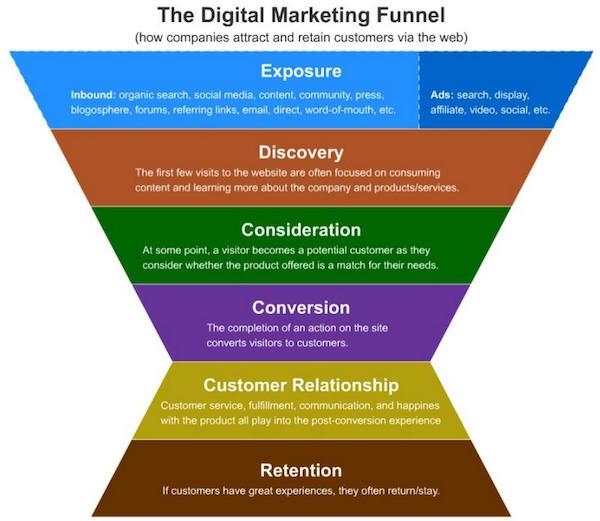
Image courtesy of MarketingProfs
But, we know it isn’t quite that simple. So, let’s add some complexity to our model of conversion.
- This funnel is leaky. Not everyone who starts at the top of the funnel-awareness-will flow through to conversion and not everyone who buys will return or recommend your brand.
- This isn’t a linear process. Visitors cycle through various stages rather than moving straight down the funnel.
- Retaining customers is super important. Relationship marketing tells us that it’s 5X more expensive to replace a dissatisfied customer than to keep them.
- Flow-through to conversion is too low.
- Not all conversion is created equal. Some visitors are “better” than others.
An alternative model is the one below on content layering (which I love because, well, who doesn’t love cake). It fixes a few problems mentioned above. But, let’s dig a little deeper and figure out how to fix all the problems above so we optimize our market returns. Since my focus is on digital, the discussion will primarily relate to online retailing.
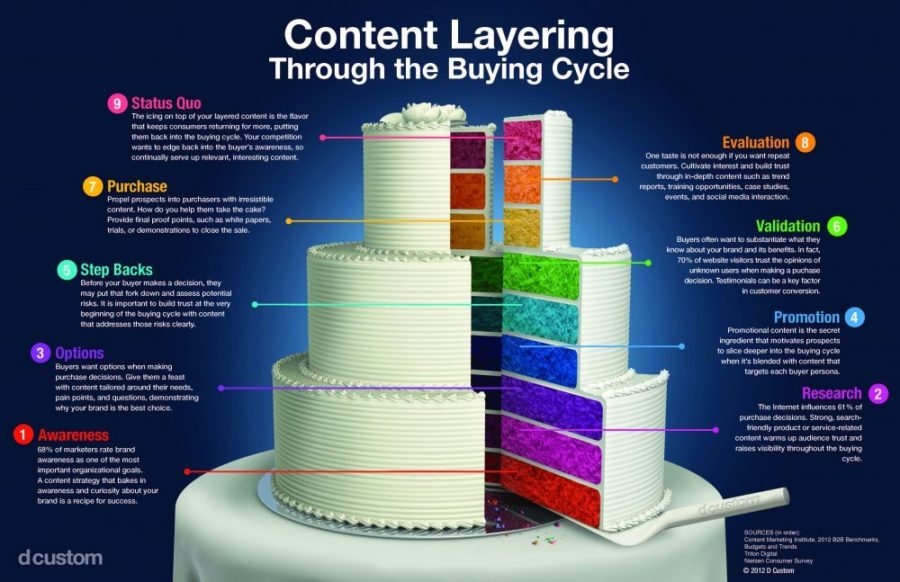
Image courtesy of i-Scoop
Problem 1: Leaky funnel
The shape of both models of moving visitors toward conversion inherently reflect the leakiness of the funnel. In reality, the average conversion rate for landing pages is a little over 2%, while the highest performing landing pages convert over 11% of visitors [cite]. It’s a little better for brick and mortar retailers, at around 20%, but that rate includes higher costs and, often, lower rates of visitors [cite]. Neither one is all that great.
Fixing the problem
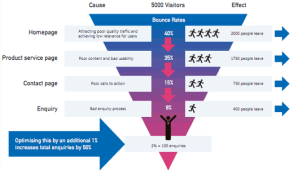
Image courtesy of Coast Digital
The first step in fixing the problem is to monitor conversion rates. Online, that seems easy: you track the number of visits and divide by the number who purchased. And, while this seems like a no-brainer, many online retailers can’t even give you this number. So, start there.
Now, look at the visits that didn’t result in a conversion. Where did visitors drop off the radar? Google Analytics offers “funnel visualization” to show you exactly where visitors went when they dropped off your page. This is very crude, but it’s a good start. Now, look at the pages involved in the process.
Now, look at the pages involved in the process. What did you say on the page? Did you provide answers to concerns visitors might have about buying from you? For instance, Zappos recognized that consumers were leery about buying shoes online. They fixed that problem by offering free returns on shoes that didn’t fit or that didn’t look good on your foot. So, you have no risk buying shoes from them and only lose a little time, as they provide return shipping labels, so all you have to do is slap the new label on the box and off they go. But, having that policy isn’t any good unless visitors know about it, so make it abundantly clear in all your messaging and hard to miss on your website.
Problem 2: Nonlinear process
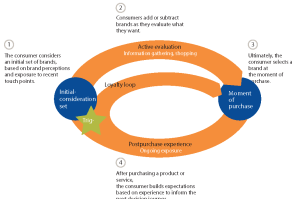 Customers don’t move down the funnel in a linear fashion. Instead, they might visit the website, check out reviews, ask some friends for feedback, look at the company’s Facebook page, forget about buying the product or decide to postpone purchase, return because they saw an ad for your product show up in search …
Customers don’t move down the funnel in a linear fashion. Instead, they might visit the website, check out reviews, ask some friends for feedback, look at the company’s Facebook page, forget about buying the product or decide to postpone purchase, return because they saw an ad for your product show up in search …
Fixing the problem
A first step in the process is to know what the process looks like and what content contributes to increased conversion. That’s hard without some way to know what the process looks like for individual visitors. And, that probably involves getting them to login, which might be counterproductive and create more leakage.
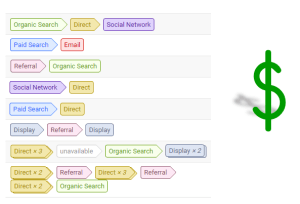
Image courtesy of Occam’s Razor
A better option might be multi-channel attribution modeling, which involves apportioning the value of a conversion across the various channels involved in the conversion. So, you would assign a value to your landing page, to Facebook, and to Adwords if the process looked like the one described above. Now, you use this information to
Now, use this information to decide how to apportion your budget; spending the most money on the channels representing the highest value in moving visitors toward conversion.
Problem 3: Importance of loyal customers
I already mentioned that a loyal customer is worth a lot. That’s because it costs 5x more to attract a new customer than retain an existing one [cite]. Across multiple clients, I consistently find that repeat visitors also buy more, thus increasing their value to a firm.
Are you doing a good job of retaining customers?
Fixing the problem
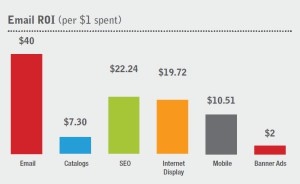
Image courtesy of Data Mentors
First, find out how effective you are in retaining existing customers. Again, using Google Analytics, you can track what proportion of your visitors visit once, twice … You can even run other reports using segmentation based on the number of visits. This tells you how much value there is in retaining customers over time.
Next, let’s talk about ways to retain the customers. You should have a mailing list (email) with customers designated in some way. Craft specific messages thanking them and rewarding them for their loyalty. For instance, I am a Lenox member. I routinely get emails offering special discounts or special shopping opportunities only open to members. Sending messages on birthdays and anniversaries is another way to show customers they are important.
Some companies invite customers to share their opinions and participate in decision-making for the firm. For instance, asking for input on new products, new logos, etc makes customers feel invested in the firm and increase loyalty rates.
Problem 4: Flow-through to conversion low
Moving visitors toward conversion requires a sustained and cohesive communication strategy at all 3 stages of the conversion process.
We commonly divide the conversion funnel into 3 stages:
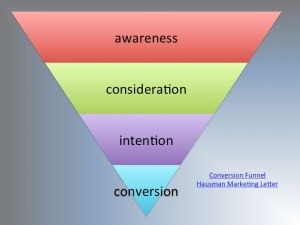 Top of funnel: Awareness
Top of funnel: Awareness
- Middle of funnel: Consideration and Intention
- Bottom of funnel: Conversion
We find businesses put too much emphasis on bottom of funnel activities and not enough on the top of the funnel. But, the middle of the funnel is often almost totally ignored in content development [cite].
As I mentioned earlier, conversion rates are only around 2%.
Fixing the problem
Create content for each stage in the conversion process and focus on a cohesive communication strategy for moving visitors toward conversion, recognizing that a small improvement at the top of the funnel generates a much bigger improvement in conversions.
Content aimed at awareness should focus on how your product fixes problems faced by consumers and it should be optimized for search since you’re casting a wide net in search of customers how need your product. That means you need research to identify the hot buttons for your target audience and how they frame queries online.
Content aimed at the consideration stage should go into more depth, providing social proof and presenting independent evidence to support your superiority.
Content aimed at the intention stage should address problem customers encounter in fulfilling their desire for your product. At this stage, you want to create content demonstrating the affordability of your product, offer discounts, identify financing options, and address other problems they might have. For instance, recognizing that customers in apartments face the problem of having deliveries stolen, Amazon opened pop-up stores, lockers, and physical stores to accept delivery and make it easy for customers to retrieve their purchases.
Problem 5: Not all visitors are the same
You probably already know this, but not all your visitors are the same. Some purchase in higher volume (average order size), some purchase more frequently, and some influence the purchases of others. You need content and strategies to attract and retain the most valuable visitors; one that highly targets them and offers something not available to lower value consumers.
This is the notion of Customer Lifetime Value (CLV). For instance, I own dogs, or, rather, they own me. Between my 2 dogs, I have 200 lbs of dog. That makes inherently more valuable to a dog food company because big dogs eat more than little dogs. So, dog food manufacturers create content to make me identify with their brand by picturing big dogs on the packaging, advertising, and websites. Expensive brands know I can’t afford them to feed my big dogs, so they focus on small breeds that make up their market.
Fixing the problem
Obviously, you need to understand how various demographic, geographic, and lifestyle groups contribute to your bottom line. Develop a clear understanding how what motivates, and what demotivates, this segment. Use this understanding to create content that resonates with them.
Digital & Social Articles on Business 2 Community
(99)
Report Post






